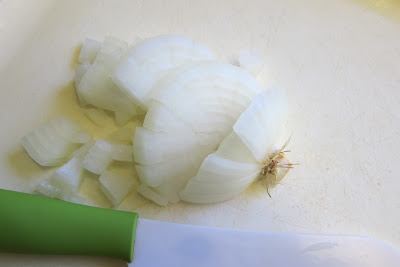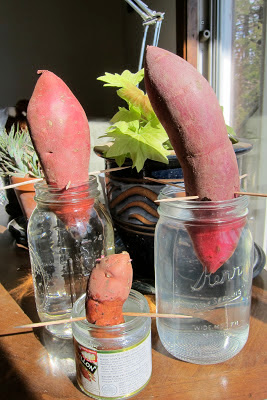It’s 63º.
Almost all of the snow has melted. The air feels balmy to us and Dennis is
sitting on the deck with a lapful of paperwork and a bottle of beer.
In the cold frame
spinach and lettuce are going to town, but the arugula is putting up seed
stalks. There’s a good reason it’s also called “rocket.”
Leaves on
the 18-month-old sweet potato I discovered sprouting in the basement last week
are growing and turning from maroon to green. Meanwhile the garnet yam is showing
a few sprouts but the Japanese yam has only one tiny root.
Best of all is the Lucy news. Yesterday
morning Dennis came in from the chicken house to announce that Lucy had died overnight,
but when he went back to dispose of her body, she jumped up and ran out into
the yard.
I have been watching Lucy closely from the kitchen window. She has spent all her days since the attack 13 days ago standing in one or the other of the far corners of the chicken yard. She even trudged through deep snow to reach a refuge. She didn’t seem to be eating and we were sure she would starve to death. Then, when Dennis took a bowl of vegetable scraps to the hens, Lucy came running but didn’t get any of the scraps because she was afraid to approach the other hens, who were gobbling up the scraps.
I have been watching Lucy closely from the kitchen window. She has spent all her days since the attack 13 days ago standing in one or the other of the far corners of the chicken yard. She even trudged through deep snow to reach a refuge. She didn’t seem to be eating and we were sure she would starve to death. Then, when Dennis took a bowl of vegetable scraps to the hens, Lucy came running but didn’t get any of the scraps because she was afraid to approach the other hens, who were gobbling up the scraps.
Chickens
are very mean-spirited birds toward one another. That’s what the term “pecking
order” is all about. They seem to have no tolerance for disability and will
drive off a wounded or sick member of their flock. Once, back when we still
kept a rooster, a hen sat on a clutch of eggs. When the eggs hatched one of the
chicks was slightly deformed. The mother hen shoved it out of the nest! I put
it back and she shoved it out again. She had no intention of raising a deformed
chick. So, none of the hens has cared a hoot whether Lucy lived or died and
they didn’t want to associate with her.
Realizing
that the other hens were keeping Lucy away from food, I crumbled a leftover
biscuit in one of her safety corners (chickens love any kind of bread) and some
“scratch” in her other safety corner. She ate and she revived. By evening of
the day we thought she had died, she was, as Dennis said, “almost a new person.” Today Lucy has been out and about, eating, but avoiding her flockmates. She, of course, is the one on the far left.
Yep, now that
we’ve made it through the winter, things are looking up.
Copyright
2013 by Shirley Domer























